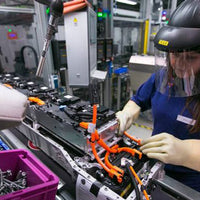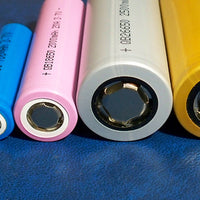RV power supply system can be said to be the most important facilities on the RV, directly related to the use of RV performance and comfort, many friends in the purchase of the RV will worry about the electricity problem. Can imagine, a perennial travel RV is used as a "mobile home" if the daily electricity can not be guaranteed, then the use of all electrical appliances will be limited, and can not play its due efficiency!
RV daily electricity, usually by external power, generators, solar panels, battery power supply, and other ways to solve. Among them, the battery power supply is the most commonly used power supply mode in the use of RV. Battery and inverter are also two core equipment that must be paid attention to in the modification or selection of RV.
First, the type of RV battery and its advantages and disadvantages
The battery of an RV is composed of a starting battery and living battery, and they are independent of each other. In the process of driving the RV, the motor will generate a power supply and directly charge the battery of the RV. Mutual loss does not occur during use.
There are two types of batteries on the market: lead-acid batteries and lithium-ion batteries.
1. Compared with batteries of other materials, lithium battery has obvious advantages in charge and discharges energy efficiency, storage capacity, volume, and weight, etc. But at the same time, there are obvious disadvantages, that is high prices and low stability. The price of lithium batteries is generally 3 to 4 times that of lead-acid batteries, which is acceptable for users who buy hundreds of thousands of RV, but the real concern is its stability. In China, lithium batteries used in motor homes catch fire from time to time. The best operating temperature of a lithium battery is 15~30℃, if the operating temperature exceeds 35℃, its performance will decline sharply, or even "crash"; When the operating temperature is lower than 5℃, the charging power of the battery will be greatly reduced, and even when the charging temperature is lower than 0℃, it will be unable to be charged. If the charging time is too long, lithium will be generated in the battery, which may cause potential safety hazards such as a short circuit in the battery cell. Despite the instability of lithium batteries, the accident rate of lithium batteries is controllable as long as it is installed and used properly.
With more than 12 years of professional experience, our Impress team has made many countermeasures to ensure the stability of Li-ion batteries, such as adding a heating system to ensure that it can work properly in an environment of -20℃; unique cooling design, so that it can work well in 60℃, please refer here for more information!
2. Lead-acid battery is an electrode material mainly made of lead and its oxides. The electrolyte is the battery of the sulfuric acid solution. The main component of the positive electrode is lead dioxide and the main component of the negative electrode is lead. In the charging state, the main components of the positive and negative electrodes are lead sulfate. A lead-acid battery can lower the power to a very low level without affecting the battery life. However, compared with lithium battery, this kind of battery has the disadvantage of relatively less power storage. Moreover, the lead-acid battery has a large volume and weight, which is generally between 16 and 30kg.
Second, the capacity of the trailer battery
1. Electric power demand estimation
You know, energy is conserved, and the total demand for our power system plus the loss of the transmission system cannot be greater than the maximum that the power system can provide. Therefore, we can deduce what kind of power supply or storage system is needed according to the demand for electricity.
First of all, you need to understand the power of your appliances, the exact value can be obtained by using the label on the back of the appliances.
Power estimation of common motor home appliances: air conditioning heating is generally about 2500W (electric auxiliary heating); General air conditioning refrigeration about 800W; Induction cooker generally about 2500W; Electric kettles are usually about 1500W. Note: motor homes are not recommended to use high-power electrical appliances. The power of a single electrical appliance should be below 3000W, and the high-power electrical appliance should not be used at the same time. This is determined by the maximum power provided by the generator or inverter we can carry. We can calculate the amount of electricity used by a single appliance according to individual needs and add them together to get the total demand. Such as:
Watching TV for 5 hours ≈280W×5h=1.4 KWH; Use the rice cooker for half an hour ≈800W×0.5h=0.4 KWH; 10 hours of air conditioning is ≈800W×10h=8 KWH. Total electricity demand: 1.4+0.4+8=9.8 KWH.
2. Energy estimation provided by the battery
Take a common lithium battery as an example: 240Ah≈2.304 KWH; 4.8 KWH 500 ah material; 5.76 KWH 600 ah material; 800 ah 7.68 electric material; 1000 ah material 9.6 KWH.
3. according to the power demand to choose the battery
From the above example, we know that our electricity demand is 9.8 kWh. According to the demand, we can see at least 1000Ah of lithium battery to meet our daily use needs. Of course, this is only a theoretical calculation, we ignore many low-power appliances, such as lighting, refrigerator, mobile phone charging, laptop, etc. Moreover, the power loss in the transmission and inverting process is not considered. When the actual choice of battery, we also want to consider the safety, price, life, use environment temperature, weight (influence RV counterweight), and other practical factors.
Three, inverter selection
1. the concept of inverter and its role
Inverter, also known as a converter, reflux device, is to convert the dc electric energy (battery, storage battery) into a constant frequency constant voltage or frequency modulation voltage regulation alternating current (generally 220V,50Hz sine wave) converter. It consists of inverter bridge, control logic, and filter circuit, and is widely used in air conditioning, home theater, electric grinding wheel, electric tools, sewing machine, DVD, VCD, computer, TV, washing machine, range hood, refrigerator, video recorder, massager, fan, lighting and other electrical equipment.
2. Inverter classification
There are two main types, one is a sinusoidal inverter, the other is a square wave inverter. The sinusoidal inverter outputs the same or better sinusoidal alternating current as of the grid we use every day. Square wave inverter output is a poor quality of the square wave alternating current.
3. Inverter selection
We must choose the inverter according to the electricity consumption of the appliance on the RV. If you need a battery to drive the air conditioning or induction cooker, at least choose an inverter over 3000W; If only need to use a rice cooker or electric kettle, at least choose 2000W above the inverter (usually trailer manufacturers only assembly 2000W below the inverter, can not be). Also, the inverter must choose a pure sine wave, do not choose a square wave (correction wave) inverter.








0 comments